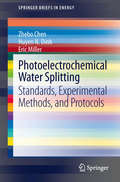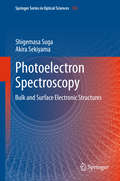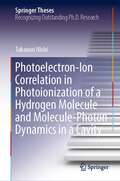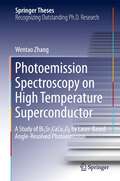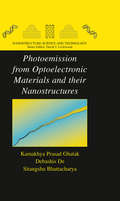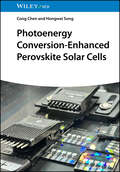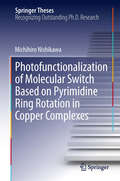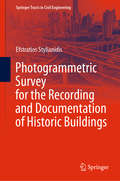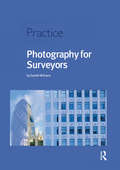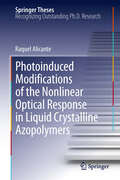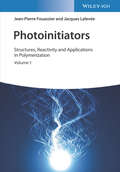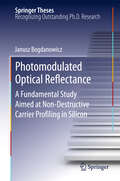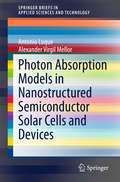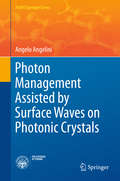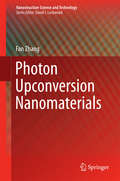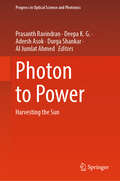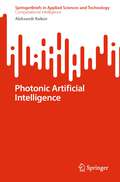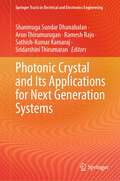- Table View
- List View
Photoelectrochemical Solar Conversion Systems: Molecular and Electronic Aspects
by Andrés G. MuñozProviding new insights into the molecular and electronic processes involved in the conversion of sunlight into chemical products, Photoelectrochemical Solar Conversion Systems: Molecular and Electronic Aspects begins with an historical overview and a survey of recent developments in the electrochemistry of semiconductors and spectroscopic technique
Photoelectrochemical Solar Fuel Production
by Sixto Giménez Juan BisquertThis book explores the conversion for solar energy into renewable liquid fuels through electrochemical reactions. The first section of the book is devoted to the theoretical fundamentals of solar fuels production, focusing on the surface properties of semiconductor materials in contact with aqueous solutions and the reaction mechanisms. The second section describes a collection of current, relevant characterization techniques, which provide essential information of the band structure of the semiconductors and carrier dynamics at the interface semiconductor. The third, and last section comprises the most recent developments in materials and engineered structures to optimize the performance of solar-to-fuel conversion devices.
Photoelectrochemical Water-splitting: Standards, Experimental Methods, and Protocols
by Eric Miller Huyen Dinh Zhebo ChenThis book outlines many of the techniques involved in materials development and characterization for photoelectrochemical (PEC) - for example, proper metrics for describing material performance, how to assemble testing cells and prepare materials for assessment of their properties, and how to perform the experimental measurements needed to achieve reliable results towards better scientific understanding. For each technique, proper procedure, benefits, limitations, and data interpretation are discussed. Consolidating this information in a short, accessible, and easy to read reference guide will allow researchers to more rapidly immerse themselves into PEC research and also better compare their results against those of other researchers to better advance materials development. This book serves as a "how-to" guide for researchers engaged in or interested in engaging in the field of photoelectrochemical (PEC) water splitting. PEC water splitting is a rapidly growing field of research in which the goal is to develop materials which can absorb the energy from sunlight to drive electrochemical hydrogen production from the splitting of water. The substantial complexity in the scientific understanding and experimental protocols needed to sufficiently pursue accurate and reliable materials development means that a large need exists to consolidate and standardize the most common methods utilized by researchers in this field.
Photoelectron Spectroscopy: Bulk and Surface Electronic Structures
by Akira Sekiyama Shigemasa SugaPhotoelectron spectroscopy is now becoming more and more required to investigate electronic structures of various solid materials in the bulk, on surfaces as well as at buried interfaces. The energy resolution was much improved in the last decade down to 1 meV in the low photon energy region. Now this technique is available from a few eV up to 10 keV by use of lasers, electron cyclotron resonance lamps in addition to synchrotron radiation and X-ray tubes. High resolution angle resolved photoelectron spectroscopy (ARPES) is now widely applied to band mapping of materials. It attracts a wide attention from both fundamental science and material engineering. Studies of the dynamics of excited states are feasible by time of flight spectroscopy with fully utilizing the pulse structures of synchrotron radiation as well as lasers including the free electron lasers (FEL). Spin resolved studies also made dramatic progress by using higher efficiency spin detectors and two dimensional spin detectors. Polarization dependent measurements in the whole photon energy spectrum of the spectra provide useful information on the symmetry of orbitals. The book deals with the fundamental concepts and approaches for the application of this technique to materials studies. Complementary techniques such as inverse photoemission, photoelectron diffraction, photon spectroscopy including infrared and X-ray and scanning tunneling spectroscopy are presented. This book provides not only a wide scope of photoelectron spectroscopy of solids but also extends our understanding of electronic structures beyond photoelectron spectroscopy.
Photoelectron-Ion Correlation in Photoionization of a Hydrogen Molecule and Molecule-Photon Dynamics in a Cavity (Springer Theses)
by Takanori NishiThis book presents the latest theoretical studies giving new predictions and interpretations on the quantum correlation in molecular dynamics induced by ultrashort laser pulses. The author quantifies the amount of correlation in terms of entanglement by employing methods developed in quantum information science, in particular applied to the photoionization of a hydrogen molecule. It is also revealed that the photoelectron–ion correlation affects the vibrational dynamics of the molecular ion and induces the attosecond-level time delay in the molecular vibration. Furthermore, the book also presents how molecular vibration can couple to photons in a plasmoic nanocavity.Physicists and chemists interested in the ultrafast molecular dynamics would be the most relevant readers. They can learn how we can employ the quantum-information-science tools to understand the correlation in the molecular dynamics and why we should consider the correlation between the photoelectron and the molecular ion to describe the ion’s dynamics. They can also learn how to treat a molecule coupled to photons in a nanocavity. All the topics are related to the state-of-the-art experiments, and so, it is important to publish these results to enhance the understanding and to induce new experiments to confirm the theory presented.
Photoemission Spectroscopy on High Temperature Superconductor
by Wentao ZhangThis book mainly focuses on the study of the high-temperature superconductor Bi2Sr2CaCu2O8 by vacuum, ultra-violet, laser-based, angle-resolved photoemission spectroscopy (ARPES). A new form of electron coupling has been identified in Bi2212, which occurs in the superconducting state. For the first time, the Bogoliubov quasiparticle dispersion with a clear band back-bending has been observed with two peaks in the momentum distribution curve in the superconducting state at a low temperature. Readers will find useful information about the technique of angle-resolved photoemission and the study of high-temperature superconductors using this technique. Dr. Wentao Zhang received his PhD from the Institute of Physics at the Chinese Academy of Sciences.
Photoemission from Optoelectronic Materials and their Nanostructures
by Debashis De Kamakhya Prasad Ghatak Sitangshu BhattacharyaIn recent years, with the advent of fine line lithographical methods, molecular beam epitaxy, organometallic vapour phase epitaxy and other experimental techniques, low dimensional structures having quantum confinement in one, two and three dimensions (such as ultrathin films, inversion layers, accumulation layers, quantum well superlattices, quantum well wires, quantum wires superlattices, magneto-size quantizations, and quantum dots) have attracted much attention not only for their potential in uncovering new phenomena in nanoscience and technology, but also for their interesting applications in the areas of quantum effect devices. In ultrathin films, the restriction of the motion of the carriers in the direction normal to the film leads to the quantum size effect and such systems find extensive applications in quantum well lasers, field effect transistors, high speed digital networks and also in other quantum effect devices. In quantum well wires, the carriers are quantized in two transverse directions and only one-dimensional motion of the carriers is allowed.
Photoenergy Conversion-Enhanced Perovskite Solar Cells
by Cong Chen Hongwei SongComprehensive presentation of upconversion luminescent materials, from fundamental theory to photovoltaic, photocatalytic, and biological applications Photoenergy Conversion-Enhanced Perovskite Solar Cells is a thorough guide to the synthesis and properties of lanthanide-based and triplet-triplet annihilation-based upconversion nanomaterials. The book reviews their diverse applications in the fields of photovoltaics, luminescent solar concentrator, photodetectors, photocatalysis, lasing, light-emitting diodes, high-resolution bioimaging, photothermal therapy, photoelectrochemical biosensors, optical temperature sensing, ion detection, anti-counterfeiting, förster resonant energy transfer, volumetric full-color displays, photonic quantum logic gates, and other optical fields. Photoenergy Conversion-Enhanced Perovskite Solar Cells explores sample topics including: Challenges in spectral response and photon management of perovskite photovoltaics (PVs) Down-conversion and down-shifting for high-energy uv utilization, with information on semiconductor oxides and carbon materials Surface plasmon resonance for light-harvesting, covering basic mechanisms as well as metal alloys and nanostructures Texturing for light-trapping, discussing electron transport layers with periodic nanostructures and texturing on glass or a transparent conductive oxide Luminescent solar concentrators for light concentration, reviewing both Pb-based and Pb-free nanocrystals Photoenergy Conversion-Enhanced Perovskite Solar Cells is an essential reference for scientists, engineers, industrial experts, and advanced students to solve fundamental and applied problems of upconversion luminescent materials and think of new innovative ideas in the field of application of phosphor materials.
Photofunctionalization of Molecular Switch Based on Pyrimidine Ring Rotation in Copper Complexes
by Michihiro NishikawaThis book provides a detailed description of photofunctionalization of molecular switch based on pyrimidine ring rotational isomerization in copper complexes bearing two bidentate ligands. The most important features of this work focus on the properties associated with the rotational isomerization based on the two possible coordination geometries at the copper center derived from two nitrogen atoms on the unsymmetrically substituted pyrimidine ring. The functions of systems such as dual emission and redox potential switching based on photo-driven rotation will be of particular interest to readers. Both the functions and the procedures for proving these phenomena are beneficial for the development of more functionalized systems based on material science, molecular science, nanoscience, nanotechnology, electrochemistry, photochemistry, coordination chemistry, physical chemistry, and related disciplines. The finding elucidated here holds promise for handling the photoprocesses of metal complexes, valid for both applications and novel properties. This system is expected make it possible to extract an electrochemical potential response from molecular switches, aiming to simulate the five senses of human beings at a single molecular level.
Photogrammetric Survey for the Recording and Documentation of Historic Buildings (Springer Tracts in Civil Engineering)
by Efstratios StylianidisThis book provides state-of-the-art information on photogrammetry for cultural heritage, exploring the problems and presenting solutions that are applicable under real-world conditions and in various disciplines. Allowing readers to gain a basic understanding of cultural heritage documentation and practical image-based modelling techniques, it focuses on the use of photogrammetry to enhance the documentation of historic buildings in order to reflect the international trends and meet demands of the preservation community. Addressing heritage documentation from various perspectives, the book will appeal students and researchers from engineering backgrounds as well as from the arts and humanities.
Photography and Other Media in the Nineteenth Century
by Simone Natale Nicoletta LeonardiIn this volume, leading scholars of photography and media examine photography’s vital role in the evolution of media and communication in the nineteenth century.In the first half of the nineteenth century, the introduction of telegraphy, the development of a cheaper and more reliable postal service, the rise of the mass-circulation press, and the emergence of the railway dramatically changed the way people communicated and experienced time and space. Concurrently, photography developed as a medium that changed how images were produced and circulated. Yet, for the most part, photography of the era is studied outside the field of media history. The contributors to this volume challenge those established disciplinary boundaries as they programmatically explore the intersections of photography and “new media” during a period of fast-paced change. Their essays look at the emergence and early history of photography in the context of broader changes in the history of communications; the role of the nascent photographic press in photography’s infancy; and the development of photographic techniques as part of a broader media culture that included the mass-consumed novel, sound recording, and cinema.Featuring essays by noteworthy historians in photography and media history, this discipline-shifting examination of the communication revolution of the nineteenth century is an essential addition to the field of media studies.In addition to the editors, contributors to this volume are Geoffrey Batchen, Geoffrey Belknap, Lynn Berger, Jan von Brevern, Anthony Enns, André Gaudreault, Lisa Gitelman, David Henkin, Erkki Huhtamo, Philippe Marion, Peppino Ortoleva, Steffen Siegel, Richard Taws, and Kim Timby.
Photography and Other Media in the Nineteenth Century
by Nicoletta Leonardi and Simone NataleIn this volume, leading scholars of photography and media examine photography’s vital role in the evolution of media and communication in the nineteenth century.In the first half of the nineteenth century, the introduction of telegraphy, the development of a cheaper and more reliable postal service, the rise of the mass-circulation press, and the emergence of the railway dramatically changed the way people communicated and experienced time and space. Concurrently, photography developed as a medium that changed how images were produced and circulated. Yet, for the most part, photography of the era is studied outside the field of media history. The contributors to this volume challenge those established disciplinary boundaries as they programmatically explore the intersections of photography and “new media” during a period of fast-paced change. Their essays look at the emergence and early history of photography in the context of broader changes in the history of communications; the role of the nascent photographic press in photography’s infancy; and the development of photographic techniques as part of a broader media culture that included the mass-consumed novel, sound recording, and cinema.Featuring essays by noteworthy historians in photography and media history, this discipline-shifting examination of the communication revolution of the nineteenth century is an essential addition to the field of media studies.In addition to the editors, contributors to this volume are Geoffrey Batchen, Geoffrey Belknap, Lynn Berger, Jan von Brevern, Anthony Enns, André Gaudreault, Lisa Gitelman, David Henkin, Erkki Huhtamo, Philippe Marion, Peppino Ortoleva, Steffen Siegel, Richard Taws, and Kim Timby.
Photography for Surveyors (Eg Practice Ser.)
by Gareth EvansVisual images play an integral part in the surveying, development and sale of a property. However, obtaining high quality images can often prove a challenging task. Photography for Surveyors provides even the most amateur photographer with the skills required to produce the highest quality images in the day to day surveying environment. With the increasing importance of the visual portfolio and online presence, this book is an essential guide for all those professionals looking to enhance their skills with a camera, and subsequently raise their professional profile.
Photoinduced Modifications of the Nonlinear Optical Response in Liquid Crystalline Azopolymers
by Raquel AlicanteNonlinear optical (NLO) phenomena such as frequency conversion have played a key role in the development of photonic technologies. This thesis reports a detailed study of the molecular response of a large variety of push-pull organic compounds using the Second Harmonic Generation technique, which will serve as a starting point for the investigation at the macroscopic scale of azobenzene-based liquid crystalline polymeric films and their blends with highly efficient NLO chromophores. These materials are designed with the aim of exploiting their photoadressability in order to tailor their nonlinear behaviour. The magnitude and symmetry of their NL response was successfully controlled via light irradiation and thermal treatments. Moreover, as a specific application, the recording of efficient NLO gratings was achieved.
Photoinitiators: Structures, Reactivity and Applications in Polymerization
by Jacques Lalevée Jean-Pierre FouassierA comprehensive text that covers everything from the processes and mechanisms to the reactions and industrial applications of photoinitiators Photoinitiators offers a wide-ranging overview of existing photoinitiators and photoinitiating systems and their uses in ever-growing green technologies. The authors—noted experts on the topic—provide a concise review of the backgrounds in photopolymerization and photochemistry, explain the available structures, and examine excited state properties, involved mechanisms, and structure, reactivity, and efficiency relationships. The text also contains information on the latest developments and trends in the design of novel tailor-made systems. The book explores the role of current systems in existing and emerging processes and applications. Comprehensive in scope, it covers polymerization of thick samples and in-shadow areas, polymerization under LEDs, NIR light induced thermal polymerization, photoinitiators for novel specific and improved properties, and much more. Written by an experienced and internationally renowned team of authors, this important book: Provides detailed information about excited state processes, mechanisms, and design of efficient photoinitiator systems Discusses the performance of photoinitiators of polymerization by numerous examples of reactions and application Includes information on industrial applications Presents a review of current developments and challenges Offers an introduction to the background information necessary to understand the field Discusses the role played by photoinitiators in a variety of different polymerization reactions Written for polymer chemists, photochemists, and materials scientists, Photoinitiators will also earn a place on the bookshelves of photochemists seeking an authoritative, one-stop guide to the processes, mechanisms, and industrial applications of photoinitiators.
Photomechanical Materials, Composites, and Systems: Wireless Transduction of Light into Work
by Timothy J. WhiteAn exhaustive review of the history, current state, and future opportunities for harnessing light to accomplish useful work in materials, this book describes the chemistry, physics, and mechanics of light-controlled systems.• Describes photomechanical materials and mechanisms, along with key applications• Exceptional collection of leading authors, internationally recognized for their work in this growing area• Covers the full scope of photomechanical materials: polymers, crystals, ceramics, and nanocomposites• Deals with an interdisciplinary coupling of mechanics, materials, chemistry, and physics• Emphasizes application opportunities in creating adaptive surface features, shape memory devices, and actuators; while assessing future prospects for utility in optics and photonics and soft robotics
Photomodulated Optical Reflectance
by Janusz BogdanowiczOne of the critical issues in semiconductor technology is the precise electrical characterization of ultra-shallow junctions. Among the plethora of measurement techniques, the optical reflectance approach developed in this work is the sole concept that does not require physical contact, making it suitable for non-invasive in-line metrology. This work develops extensively all the fundamental physical models of the photomodulated optical reflectance technique and introduces novel approaches that extend its applicability from dose monitoring towards detailed carrier profile reconstruction. It represents a significant breakthrough in junction metrology with potential for industrial implementation.
Photon Absorption Models in Nanostructured Semiconductor Solar Cells and Devices
by Antonio Luque Alexander Virgil MellorThis book is intended to be used by materials and device physicists and also solar cells researchers. It models the performance characteristics of nanostructured solar cells and resolves the dynamics of transitions between several levels of these devices. An outstanding insight into the physical behaviour of these devices is provided, which complements experimental work. This therefore allows a better understanding of the results, enabling the development of new experiments and optimization of new devices. It is intended to be accessible to researchers, but also to provide engineering tools which are often only accessible to quantum physicists. Photon Absorption Models in Nanostructured Semiconductor Solar Cells and Devices is intended to provide an easy-to-handle means to calculate the light absorption in nanostructures, the final goal being the ability to model operational behaviour of nanostructured solar cells. It allows researchers to design new experiments and improve solar cell performances, and offers a means for the easy approximate calculation of the energy spectrum and photon absorption coefficients of nanostructures. This calculation is based on the effective mass model and uses a new Hamiltonian called the Empirical kp Hamiltonian, which is based on a four band kp model.
Photon Counting Computed Tomography: Clinical Applications, Image Reconstruction and Material Discrimination
by Krzysztof Kris Iniewski Scott HsiehThis book will provide readers with a good overview of some of most recent advances in the field of Photon Counting CT technology for X-ray medical imaging, especially as it pertains to new detectors. There will be a good mixture of general chapters in both technology and applications in CT medical imaging. The book will have an in-depth review of the research topics from world-leading specialists in the field. The conversion of the X-ray signal into analogue/digital value will be covered in some chapters. The authors also provide a review of CMOS chips for X-ray image sensors, methods of material discrimination and image reconstruction techniques.Covers a broad range of topics, including an introduction to novel spectral Computed Tomography;Includes in-depth analysis on how to optimize X-ray detection;Discusses analysis of electronics for X-ray detection.
Photon Counting Detectors for X-ray Imaging: Physics and Applications
by Hiroaki Hayashi Natsumi Kimoto Takashi Asahara Takumi Asakawa Cheonghae Lee Akitoshi KatsumataThis book first provides readers with an introduction to the underlying physics and state-of-the-art application of photon counting detectors for X-ray imaging. The authors explain that a photon-counting imaging detector can realize quantitative analysis because the detector can derive X-ray attenuation information based on the analysis of intensity changes of individual X-ray. To realize this analysis, it is important to consider the physics of an object and detector material. In this book, the authors introduce a novel analytical procedure to create quantitative X-ray images for medical diagnosis.
Photon Management Assisted by Surface Waves on Photonic Crystals
by Angelo AngeliniThis book illustrates original pathways to manipulate light at the nanoscale by means of surface electromagnetic waves (here, Bloch surface waves, BSWs) on planar dielectric multilayers, also known as one-dimensional photonic crystals. This approach is particularly valuable as it represents an effective alternative to the widely exploited surface plasmon paradigm. After a brief overview on the fundamentals of BSWs, several significant applications of BSW-sustaining structures are described. Particular consideration is given to the propagation, guiding, and diffraction of BSW-coupled radiation. Further, the interaction of organic emitters with BSWs on planar and corrugated multilayers is investigated, including fluorescence beaming in free space. To provide greater insight into sensing applications, an illustrative example of fluorescent microarray-based detection is presented. The book is intended for scientists and researchers working on photon management opportunities in fields such as biosensing, optical circuitry, and lighting.
Photon Upconversion Nanomaterials
by Fan ZhangThis book introduces the latest advances made in both fundamental studies and potential applications of upconversion nanomaterials, particularly in the field of high-resolution in vitro bioanalysis and in vivo imaging. This book starts with the synthesis and characterization, and focuses on applications ranging from materials science to biology. Above all, it describes cutting-edge advances in upconversion nanophosphor (UCNP)-based applications in multiplexed encoding, guest delivery and release systems, photodynamic therapy (PDT), solar cells, photocatalysis and so on. The major barriers that currently prevent UCNPs from being used in mainstream applications are also presented in detail.
Photon to Power: Harvesting the Sun (Progress in Optical Science and Photonics #32)
by Prasanth Ravindran Deepa K. G. Adersh Asok Durga Shankar Al Jumlat AhmedThis book comprehensively explores the multifaceted realm of solar energy conversion, delving into various cutting-edge technologies and methodologies spanning photovoltaics, thermal energy conversion, electrochemical energy conversion, innovative approaches, and solar optics. It provides a thorough understanding of the principles, advancements, and challenges across these domains, catering to researchers, practitioners, and academics in the field of optical sciences and photonics.
Photonic Artificial Intelligence (SpringerBriefs in Applied Sciences and Technology)
by Aleksandr RaikovThis book addresses an attempt to create Photonic Artificial Intelligence (PAI) system based on optical technologies, which process signals continuously. PAI could help to overcome digital computer limits and almost zero out the machine learning time and AI inference. It helps to consider feelings, the chaos of thoughts, cognitive activity, and the transcendental states of the human mind in AI systems. The book also discusses new problems such as synthesizing new photonic materials, creating optical control systems, and connecting PAI systems with outside digital computers and holographic memory. The book is aimed at a wide range of readers, including postgraduates and researchers, interested in advanced AI by creating its new paradigm, which can help to overcome traps of traditional AI development.
Photonic Crystal and Its Applications for Next Generation Systems (Springer Tracts in Electrical and Electronics Engineering)
by Ramesh Raju Sathish-Kumar Kamaraj Arun Thirumurugan Shanmuga Sundar Dhanabalan Sridarshini ThirumaranThis book covers the advanced fabrication techniques, challenges, and applications of photonic crystals for next-generation systems in various applications such as high-speed networks, photonic integrated circuits, health care, sensors, energy, and environmental. This book highlights the literature and works put forward by various scientists, researchers, and academicians in photonic crystals and their real-time applications. The content of the book appeals to readers such as students, researchers, and industrial engineers who are working in the design and development of photonics-based concepts, components, and devices for various applications.


